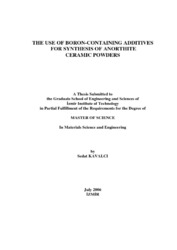Please use this identifier to cite or link to this item:
https://hdl.handle.net/11147/3409Full metadata record
| DC Field | Value | Language |
|---|---|---|
| dc.contributor.advisor | Akkurt, Sedat | - |
| dc.contributor.author | Kavalcı, Sedat | - |
| dc.date.accessioned | 2014-07-22T13:51:29Z | - |
| dc.date.available | 2014-07-22T13:51:29Z | - |
| dc.date.issued | 2006 | - |
| dc.identifier.uri | http://hdl.handle.net/11147/3409 | - |
| dc.description | Thesis (Master)--Izmir Institute of Technology, Materials Science and Engineering, Izmir, 2006 | en_US |
| dc.description | Includes bibliographical references (leaves: 57-59) | en_US |
| dc.description | Text in English; Abstract: Turkish and English | en_US |
| dc.description | ix, 59 leaves | en_US |
| dc.description.abstract | Anorthite ceramics have a great potential as a substrate material due to their low thermal expansion coefficient and low dielectric constant. For lowering the sintering temperature of anorthite ceramics several routes like employing additives, sol-gel method and the use of mechanochemical methods have been proposed.In this study, anorthite was synthesized by using mechanochemical methods and boron oxide addition. The raw materials used in this study were Sivas kaolin as a source for Al2O3 and SiO2, calcined alumina or Al(OH)3 as a source for Al2O3 and calcite powder as source for CaO. Phase characterizations of synthesized powders were performed by XRD using CuK radiation. Microstructural characterization was performed by SEM. Statistical experimental design techniques (SED) were used in order to determine and analyze the more important process variables for synthesizing anorthite ceramics. The results of screening experimental design clarified that the temperature was the most important process variable. Second most important process variable was grinding speed which was followed by additive amount and additive type. This study showed that both additive type and additive amount were important process variables because these two factors were related to each other.The effect of both additive use and grinding on anorthite synthesis helped decrease the synthesis temperature down to 900 oC. | en_US |
| dc.language.iso | en | en_US |
| dc.publisher | Izmir Institute of Technology | en_US |
| dc.rights | info:eu-repo/semantics/openAccess | en_US |
| dc.subject.lcc | TP815 .K21 2006 | en |
| dc.subject.lcsh | Ceramic powders | en |
| dc.subject.lcsh | Boric acid | en |
| dc.subject.lcsh | X-rays--Diffraction | en |
| dc.title | The Use of Boron-Containing Additives for Synthesis of Anorthite Ceramic Powders | en_US |
| dc.type | Master Thesis | en_US |
| dc.institutionauthor | Kavalcı, Sedat | - |
| dc.department | Thesis (Master)--İzmir Institute of Technology, Materials Science and Engineering | en_US |
| dc.relation.publicationcategory | Tez | en_US |
| dc.identifier.wosquality | N/A | - |
| dc.identifier.scopusquality | N/A | - |
| item.cerifentitytype | Publications | - |
| item.languageiso639-1 | en | - |
| item.openairetype | Master Thesis | - |
| item.openairecristype | http://purl.org/coar/resource_type/c_18cf | - |
| item.fulltext | With Fulltext | - |
| item.grantfulltext | open | - |
| Appears in Collections: | Master Degree / Yüksek Lisans Tezleri | |
Files in This Item:
| File | Description | Size | Format | |
|---|---|---|---|---|
| T000561.pdf | MasterThesis | 1.97 MB | Adobe PDF |  View/Open |
CORE Recommender
Page view(s)
272
checked on Apr 14, 2025
Download(s)
216
checked on Apr 14, 2025
Google ScholarTM
Check
Items in GCRIS Repository are protected by copyright, with all rights reserved, unless otherwise indicated.